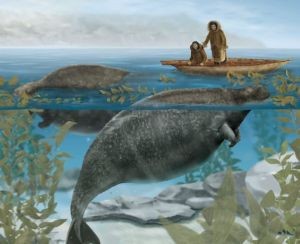Undoubtedly the darlings of Pacific Northwest megafauna, whales have captured our imagination for centuries. Vicious killers, gentle grazers, awe-inspiring and reverent, whales have filled human culture with imagery and lore that persists to this day. But are whales truly the first and only ’monster-mammals’ of the Salish Sea? I undertook to discover other inhabitants of our mysterious waters and along the way, found myself face-to-flipper with a behemoth that vanished from our midst centuries ago.
Imagine yourself perched above the intertidal, kelp below slowly bobbing in the gentle waves when suddenly you see an enormous form floating around the corner. At first you think it might be a capsized boat, until you realize that it’s moving with purpose. A porpoise, then? A huge seal or a small whale? The creature slides slowly through the water and approaches the shore. You can barely believe your eyes as the enormous animal heads for the nearest rock and pulls its bulk partially out of the water with small front flippers. Its black skin shines in the sunlight as it absentmindedly masticates a tangled blade of kelp. You have just been fortunate enough to glimpse Hydrodamalis gigas or, Steller’s Sea Cow.
Unfortunately such a scenario is all but impossible in modern times as the last known Steller’s Sea Cows became extinct in 1768, a mere 27 years after their ‘discovery’ in the Commander Islands by a group of European explorers led by Vitus Bering. At their peak, the Sea Cows inhabited a range from California to Japan and represented a major consumer of intertidal algae. Nearly 8 meters when fully grown and up to 10 tons they positively dwarfed their closest relatives the manatee and dugong. These giants represented the largest sea mammal besides whales to occupy Northwest waters. Of course the Sea Cows of the Salish Sea disappeared long before the last of their kind was encountered in the Commanders by Europeans, though they did suffer a very similar fate.
Slow moving and slow to reproduce, Steller’s Sea Cows were the target ofunsustainable overhunting from which they were unable to recover. The last population in the Commanders was quickly decimated by expedition ships which hunted the animals as an easily accessible and long-lasting food source. Historic populations most likely also fell prey to over-exploitation by indigenous peoples, some of whom described the hunting of Sea Cows as ‘womens work’. As with most of the megafauna of the Pleistocene and Holocene, Steller’s Sea Cow went the way of the Mammoth, though it did enjoy an unusually longer stint compared to most of its megafaunal contemporaries.
So although whales continue to capture the hearts and minds of those who would study them here in the Northwest, it’s worth remembering all those organisms that came before. By understanding the place of Stellar’s Sea Cow in its environment as well as the effect of humans on their population, we may find a way to prevent the whales from following the same path as the late, the great, Hydrodamalis gigas.



